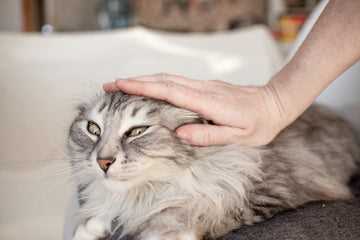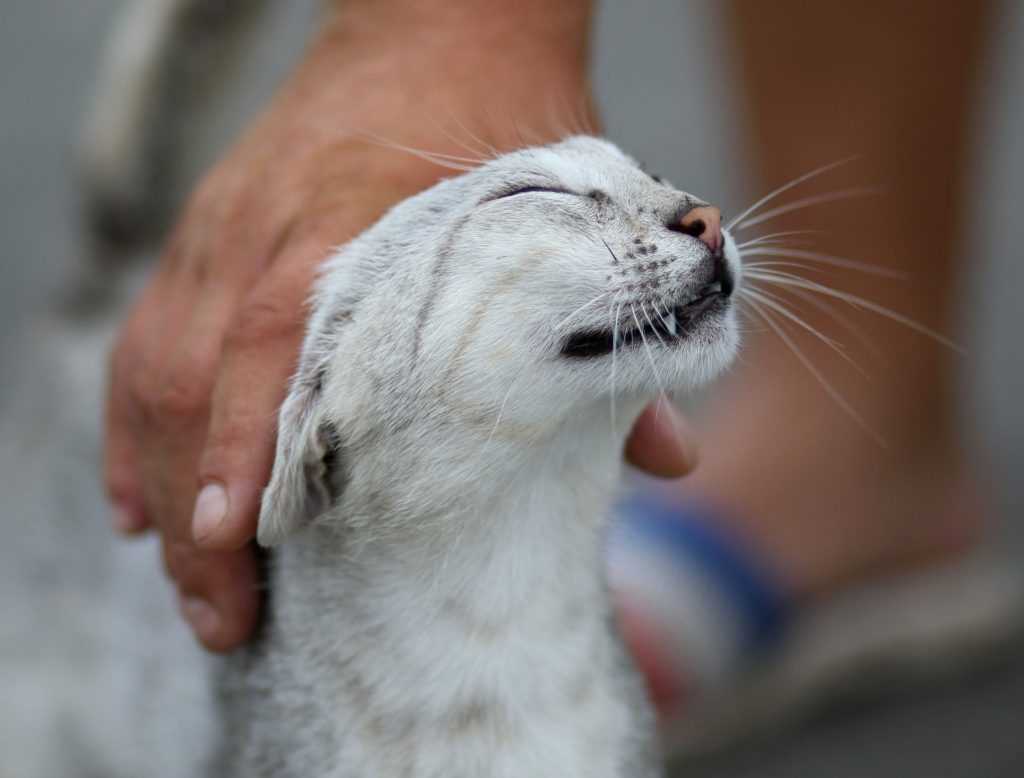

Absolutely! Head rubs are one of my favorite things. When a human reaches out and gently strokes my noggin, it feels warm and comforting. This spot is often a safe zone for affectionate gestures, as it mimics the way my feline friends greet one another.
Research indicates that many of us appreciate this form of interaction, particularly when it’s done calmly. It’s essential for my human to approach slowly and observe my body language. A relaxed posture and purring indicate that I’m enjoying it, while sudden movements might signal that I need space.
Different areas on my head can trigger varying responses. Soft strokes along my cheeks and forehead usually elicit positive reactions, while touching my ears or whiskers can be a bit overwhelming. Understanding my preferences helps build a stronger bond and ensures a delightful experience for both of us.
Do Cats Enjoy Head Rubs?
Definitely! Many felines appreciate gentle strokes on their crowns. However, the response can vary based on individual personality and past experiences.
Signs of Enjoyment

- Purring softly
- Leaning into the touch
- Slow blinking
- Relaxed body posture
How to Approach

- Start with a light touch to gauge comfort.
- Focus on areas around the ears and cheeks first.
- Watch for any signs of discomfort, like twitching or moving away.
- Respect their space; if they walk away, let them be.
Every interaction is unique. Pay attention to how your friend reacts to find what they truly enjoy!
Understanding Feline Body Language
Observe the tail. A high, upright tail indicates contentment, while a low or tucked tail suggests discomfort. The position and movement of my tail convey a lot about my feelings.
Ears are also key indicators. Forward-facing ears show curiosity or excitement, while flattened ears signal fear or irritation. Pay attention to these cues to gauge my mood.
Facial Expressions
A relaxed face, with slow blinking, is a sign of trust. Quick blinks can be an invitation for interaction. If my whiskers are pulled back, it could mean I’m feeling threatened or defensive.
Body Posture
When lounging with a stretched-out body, I’m at ease. If I curl up tightly, it’s a sign I want to feel secure. A slow approach and gentle movements will help ensure a positive interaction.
| Body Language | Meaning |
|---|---|
| High tail | Happy and confident |
| Flattened ears | Angry or scared |
| Slow blink | Trust and affection |
| Curled body | Seeking comfort |
Understanding these signals will help you interact with me in a way that respects my feelings and enhances our bond.
Preferred Petting Zones for Cats
For maximum comfort, focus on my cheeks and under my chin. These areas are often well-received, as they mimic grooming from my fellow felines.
Another favorite is the base of my ears. A gentle scratch here can elicit purring and a relaxed demeanor. Pay attention to the response; if I lean into your touch, it’s a good sign!
Don’t forget about my back! Light strokes along my spine can be enjoyable, but avoid the tail area unless I show interest. Many prefer not to be touched there, so observe my reactions closely.
Understanding these zones enhances our bond. Always approach with a calm demeanor and let me initiate contact. That way, our interactions are more pleasant.
Lastly, be aware of my mood. If I seem aloof or distant, it’s best to give me space. Respect my boundaries, and I’ll appreciate your affection even more.
Signs Your Cat Enjoys Head Pets
When I’m receiving attention, there are clear indicators that show my approval. If I lean into your hand while you’re offering affection, it’s a strong sign that I relish the contact. My purring and kneading can also be good indicators of contentment during these moments.
Watch for my tail; if it’s held high and twitching slightly, I’m likely feeling comfortable and happy. Another telltale sign is my eyelids. If I give you slow blinks while you’re close, it’s my way of saying I trust you and appreciate your touch.
If I rub my face against your hand or push my forehead into you, I’m marking you with my scent, which means I feel safe and loved. These actions express that I enjoy our time together.
Don’t forget to pay attention to my ears. If they are relaxed and facing forward, it indicates that I’m in a good mood. In contrast, if they flatten against my head, it might mean I need a break from the interaction.
For those moments when I seem extra playful, you might notice me rolling over or presenting my belly. While this can sometimes indicate a desire for more attention, be cautious since not all of us enjoy belly rubs!
Understanding these signals can enhance our bond. And while you’re spoiling me with affection, consider treating me to some delicious food too! Check out the best canned chicken for cats for a yummy addition to my meals.
Common Misconceptions About Cat Affection
Many believe that I only enjoy attention on certain spots, but that’s not the whole story. Here are some common myths about our affection preferences:
- All cats dislike physical contact: Some of us thrive on interaction, especially in familiar environments.
- Only certain breeds appreciate affection: Individual personalities matter more than breed characteristics.
- Petting is always welcome: My mood changes. Sometimes I want cuddles; other times, I prefer space.
- All pets should be gentle: I appreciate firm strokes, but it varies from one individual to another.
Understanding Unique Preferences

Every feline has distinct likes and dislikes. For many, the context of the interaction impacts enjoyment. For instance, a quiet evening might make one more receptive than a busy day.
Socialization and Environment
My comfort level grows with positive experiences. A calm home contributes to a more affectionate demeanor. Keep that in mind when trying to connect!
How to Approach a Cat for Head Petting
Always approach slowly and calmly. Begin by allowing me to see you from a distance. It’s essential to respect my personal space. I’ll appreciate it if you crouch down to my level; this feels less intimidating.
Extend your hand slowly, palm facing up. This gesture is non-threatening and gives me a chance to sniff and assess the situation. Wait for my response; if I lean in or nuzzle your hand, it’s a good sign. If I back away, give me more time.
Timing Matters
Choose moments when I’m relaxed or playing. Avoid trying to initiate contact when I’m in a restless or agitated state. Observing me is key; I’ll let you know when I’m open to interaction. If I’m lying down or stretching, it’s often a perfect opportunity.
Follow My Cues
Pay attention to my body language. If my ears are forward and my tail is held high, I’m likely feeling friendly. If I start flicking my tail or flattening my ears, it’s best to back off. Respecting my signals ensures a positive experience.
Alternatives to Head Petting for Feline Comfort
If you’re looking for ways to show affection without focusing on my crown, consider these spots: cheeks, under the chin, and along the back. Each area has its own charm and can be just as enjoyable.
Cheek rubs are a favorite; it’s where I have scent glands, so it feels extra special. Gently stroking from the cheeks to the chin can elicit purring and head butts, which is a sign of happiness.
Under the chin is another sweet spot. A light scratch or caress can result in delightful head tilts and soft vocalizations. This area often invites a response that suggests contentment and trust.
When it comes to the back, a slow stroke from the neck to the tail can be soothing. Be mindful of my body language; if I lean into your hand, it indicates enjoyment. Avoid the tail area unless I signal otherwise, as it can be sensitive for some.
Experiment with gentle, rhythmic movements. Some of us appreciate a light massage on the shoulders or between the ears, which can help relieve tension and create a bonding experience.
Always observe my reactions. If I seem to pull away or my ears flatten, it might be best to switch to a different approach. Communication is key; I’ll let you know what I prefer.
For additional tips on creating a comfortable environment, check out this resource on how to lower magnesium in reef tank.
When to Avoid Petting Your Cat on the Head
Skip the head rubs during moments of stress. If I’m hiding or showing signs of anxiety, it’s best to respect my space. Sudden movements or loud noises can trigger my flight response, making me less receptive.
Don’t approach me if I’ve just woken up. I might still be in a groggy state and prefer to gather my bearings before engaging. A sleepy mood can lead to swatting or hissing.
If I’m engrossed in play or hunting behavior, save those strokes for later. My instincts kick in, and I might perceive your hand as a distraction or even a target.
Avoid initiating contact if my ears are pinned back or tail is puffed up. These are clear signals of discomfort or irritation, indicating that I need distance.
During feeding time, I may be focused on my meal and not appreciate interruptions. Wait until I’m finished before attempting any affectionate gestures.
Lastly, when I’m with other animals, especially if tensions are high, it’s wise to keep your hands to yourself. I might feel protective or threatened, and interactions can escalate quickly.
FAQ:
Do all cats enjoy being petted on the head?
No, not all cats enjoy being petted on the head. Each cat has its own personality and preferences. Some may find head pets comforting and enjoyable, while others may feel threatened or uncomfortable with such contact. It’s important to observe a cat’s body language and behavior to determine if they like being petted in that area.
What signs indicate that a cat likes being petted on the head?
When a cat enjoys being petted on the head, it may display certain behaviors such as purring, leaning into the hand, or closing its eyes. Additionally, they might nuzzle against the person or gently head-butt them. These signs suggest that the cat feels safe and comfortable with the interaction.
Are there specific breeds of cats that prefer head petting more than others?
While individual preferences vary widely, some cat breeds are known for their affectionate nature and may be more likely to enjoy head petting. Breeds like Ragdolls, Siamese, and Maine Coons are often more sociable and may seek out attention. However, it’s important to remember that personality is more significant than breed when it comes to petting preferences.
How can I tell if my cat is uncomfortable with being petted on the head?
If a cat is uncomfortable with head petting, it may show signs such as flattening its ears, twitching its tail, or trying to move away. Additionally, a cat may hiss or swat if it feels threatened. Understanding these cues is essential to respecting the cat’s boundaries and ensuring a positive interaction.
What alternatives to head petting do cats generally prefer?
Many cats enjoy being petted on their cheeks, under the chin, or along their back. Some may also appreciate gentle strokes along their sides or belly, although this varies from cat to cat. It’s best to experiment with different areas to see what your cat enjoys most, always paying attention to their reactions.









